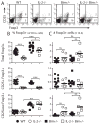Cutting edge: mechanisms of IL-2-dependent maintenance of functional regulatory T cells
- PMID: 21037099
- PMCID: PMC3059533
- DOI: 10.4049/jimmunol.0903940
Cutting edge: mechanisms of IL-2-dependent maintenance of functional regulatory T cells
Abstract
IL-2 controls the survival of regulatory T cells (Tregs), but it is unclear whether IL-2 also directly affects Treg suppressive capacity in vivo. We have found that eliminating Bim-dependent apoptosis in IL-2- and CD25-deficient mice restored Treg numbers but failed to cure their lethal autoimmune disease, demonstrating that IL-2-dependent survival and suppressive activity can be uncoupled in Tregs. Treatment with IL-2-anti-IL-2-Ab complexes enhanced the numbers and suppressive capacity of IL-2-deprived Tregs with striking increases in CD25, CTLA-4, and CD39/CD73 expression. Although cytokine treatment induced these suppressive mechanisms in both IL-2(-/-) and IL-2(-/-)Bim(-/-) mice, it only reversed autoimmune disease in the latter. Our results suggest that successful IL-2 therapy of established autoimmune diseases will require a threshold quantity of Tregs present at the start of treatment and show that the suppressive capacity of Tregs critically depends on IL-2 even when Treg survival is independent of this cytokine.
Figures




Similar articles
-
Cutting edge: regulatory T cells do not mediate suppression via programmed cell death pathways.J Immunol. 2011 Nov 1;187(9):4416-20. doi: 10.4049/jimmunol.1100548. Epub 2011 Sep 26. J Immunol. 2011. PMID: 21949016 Free PMC article.
-
A major role for Bim in regulatory T cell homeostasis.J Immunol. 2011 Jan 1;186(1):156-63. doi: 10.4049/jimmunol.1001505. Epub 2010 Nov 22. J Immunol. 2011. PMID: 21098226 Free PMC article.
-
Preferential control of induced regulatory T cell homeostasis via a Bim/Bcl-2 axis.Cell Death Dis. 2012 Feb 9;3(2):e270. doi: 10.1038/cddis.2012.9. Cell Death Dis. 2012. PMID: 22318539 Free PMC article.
-
Stimulation of α7 nicotinic acetylcholine receptor by nicotine increases suppressive capacity of naturally occurring CD4+CD25+ regulatory T cells in mice in vitro.J Pharmacol Exp Ther. 2010 Dec;335(3):553-61. doi: 10.1124/jpet.110.169961. Epub 2010 Sep 15. J Pharmacol Exp Ther. 2010. PMID: 20843956
-
Feedback loop of immune regulation by CD4+CD25+ Treg.Immunobiology. 2009;214(4):291-302. doi: 10.1016/j.imbio.2008.09.004. Epub 2008 Nov 1. Immunobiology. 2009. PMID: 19327546
Cited by
-
The cAMP Pathway as Therapeutic Target in Autoimmune and Inflammatory Diseases.Front Immunol. 2016 Mar 31;7:123. doi: 10.3389/fimmu.2016.00123. eCollection 2016. Front Immunol. 2016. PMID: 27065076 Free PMC article. Review.
-
IL-15 Fosters Age-Driven Regulatory T Cell Accrual in the Face of Declining IL-2 Levels.Front Immunol. 2013 Jun 24;4:161. doi: 10.3389/fimmu.2013.00161. eCollection 2013. Front Immunol. 2013. PMID: 23805138 Free PMC article.
-
α-galactosylceramide generates lung regulatory T cells through the activated natural killer T cells in mice.J Cell Mol Med. 2019 Feb;23(2):1072-1085. doi: 10.1111/jcmm.14008. Epub 2018 Nov 13. J Cell Mol Med. 2019. PMID: 30421497 Free PMC article.
-
Organ-specific and memory treg cells: specificity, development, function, and maintenance.Front Immunol. 2014 Jul 15;5:333. doi: 10.3389/fimmu.2014.00333. eCollection 2014. Front Immunol. 2014. PMID: 25076948 Free PMC article. Review.
-
Characterization of human epithelial resident memory regulatory T cells.Front Immunol. 2022 Aug 19;13:962167. doi: 10.3389/fimmu.2022.962167. eCollection 2022. Front Immunol. 2022. PMID: 36059538 Free PMC article.
References
-
- Hoyer KK, Dooms H, Barron L, Abbas AK. Interleukin-2 in the development and control of inflammatory disease. Immunol Rev. 2008;226:19–28. - PubMed
-
- Malek TR. The biology of interleukin-2. Annu Rev Immunol. 2008;26:453–479. - PubMed
-
- Sadlack B, Merz H, Schorle H, Schimpl A, Feller AC, Horak I. Ulcerative colitis-like disease in mice with a disrupted interleukin-2 gene. Cell. 1993;75:253–261. - PubMed
-
- Willerford DM, Chen J, Ferry JA, Davidson L, Ma A, Alt FW. Interleukin-2 receptor alpha chain regulates the size and content of the peripheral lymphoid compartment. Immunity. 1995;3:521–530. - PubMed
-
- Malek TR, Yu A, Vincek V, Scibelli P, Kong L. CD4 regulatory T cells prevent lethal autoimmunity in IL-2Rbeta-deficient mice. Implications for the nonredundant function of IL-2. Immunity. 2002;17:167–178. - PubMed
Publication types
MeSH terms
Substances
Grants and funding
LinkOut - more resources
Full Text Sources
Research Materials

